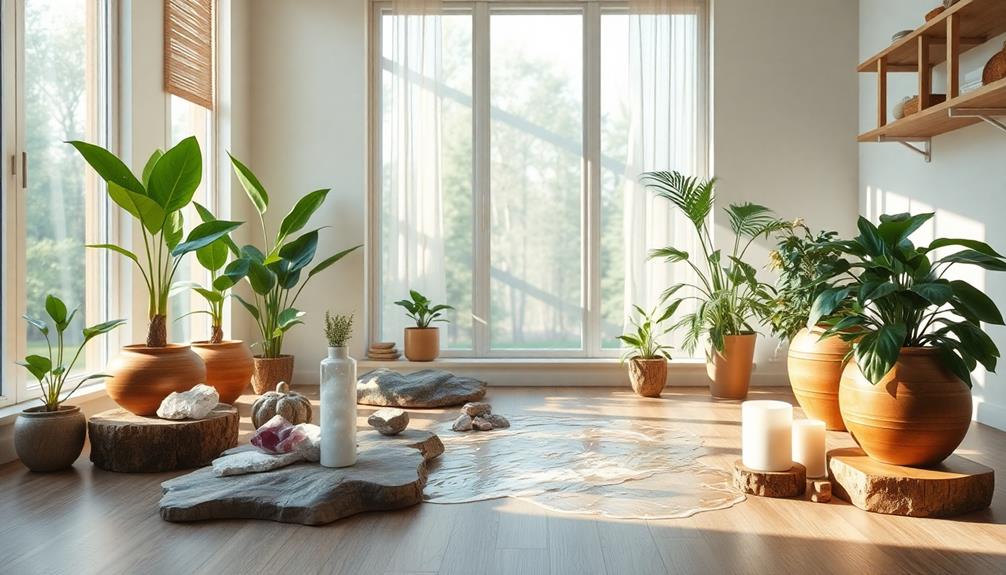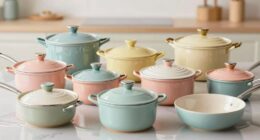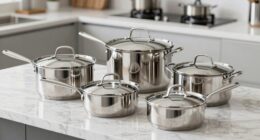Feng Shui is your key to revealing balance and harmony in your life. It focuses on optimizing the flow of Chi, which is essential for your well-being. By embracing the principles of Yin and Yang, you can create a space that promotes both activity and relaxation. Incorporating natural elements like wood and stone enhances positive energy while decluttering your environment allows for better Chi flow. Using the Bagua map can guide you in aligning your surroundings with various life aspects. If you're curious about practical applications and tips for creating harmony, there's much more to explore.
Key Takeaways
- Feng Shui optimizes Chi flow, promoting well-being through balanced environments that incorporate natural materials and a clutter-free space.
- Understanding Yin and Yang is essential for achieving harmony, as it balances passive and active energies in your living space.
- The Five Elements Theory (Wood, Fire, Earth, Metal, Water) provides unique qualities that enhance spatial harmony and support various life aspects.
- Utilizing the Bagua map helps align your space with key life areas, ensuring that each section supports your goals and aspirations effectively.
- Regularly decluttering, maximizing natural light, and strategically arranging furniture can significantly improve the energy flow and overall atmosphere of your environment.
Understanding Feng Shui Principles
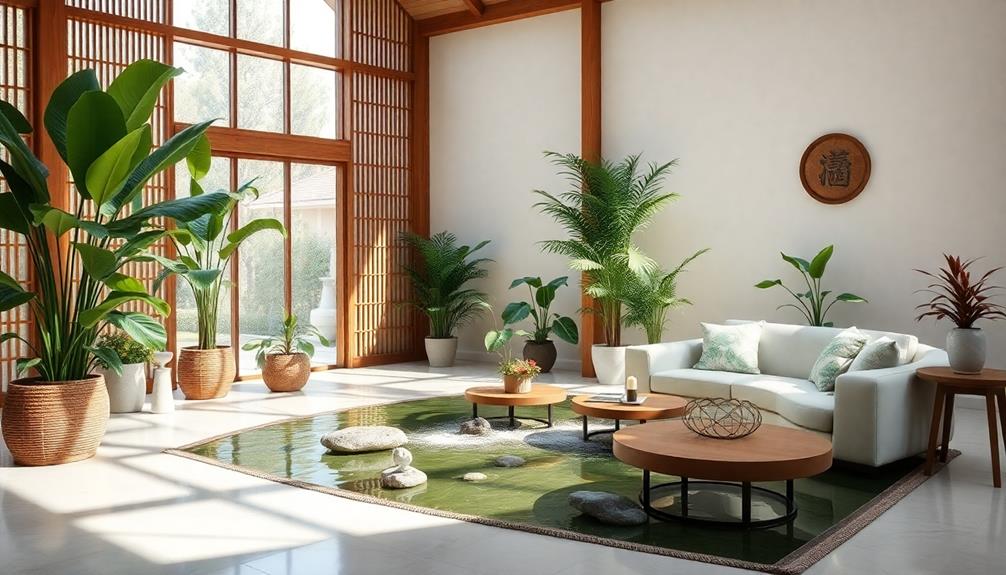
Feng Shui, often seen as the art of arranging your space, is rooted in the belief that our environments profoundly impact our well-being. This ancient practice emphasizes creating balance and harmony by optimizing the energy flow, or Chi, in your surroundings.
To understand Feng Shui principles, start with the concepts of Yin and Yang, which represent opposing forces that need to coexist in harmony. Incorporating natural materials such as wood and stone, as seen in Balinese Interior Design concepts, can further enhance the flow of positive energy in your space.
Next, familiarize yourself with the Five Elements: Wood, Fire, Earth, Metal, and Water. Each element corresponds to specific colors, shapes, and directions, influencing the energy in your space. For example, Wood symbolizes growth with the color green and rectangular shapes, while Water embodies fluidity with blue tones and curved forms.
A clutter-free environment is essential in Feng Shui, as it promotes positive Chi flow and enhances your well-being.
Historical Background of Feng Shui

Rooted in ancient traditions, the practice of Feng Shui has evolved considerably over the past 3,000 years, beginning with burial customs intended to benefit future generations. This ancient Chinese practice, which translates to "wind and water," emphasizes the importance of balance and harmony in both life and environment.
The earliest references to Feng Shui appear in the Book of Burial by Guo Pu during the Jin Dynasty, showcasing its cultural significance. Additionally, similar to the architectural styles seen in traditional Indonesian housing, Feng Shui principles often incorporate spiritual elements and cultural symbolism, further highlighting the connection between environment and well-being.
As you explore deeper into its historical background, you'll notice that during the Tang Dynasty, Feng Shui expanded to include architecture, affecting how buildings were strategically placed. This shift marked a significant evolution in urban planning.
By the Ming Dynasty, particularly through Zhang Jing-yue's influential work, The Classic of Feng Shui, the practice became formalized as a systematic method.
Even during the Qing Dynasty, despite scholarly criticisms, Feng Shui gained widespread popularity. Its principles captured global interest in the 20th century, as a growing fascination with Eastern spirituality and holistic living emerged.
Understanding this historical context enriches your journey into the transformative world of Feng Shui, guiding you towards achieving balance and harmony in your life.
Core Concepts Explained
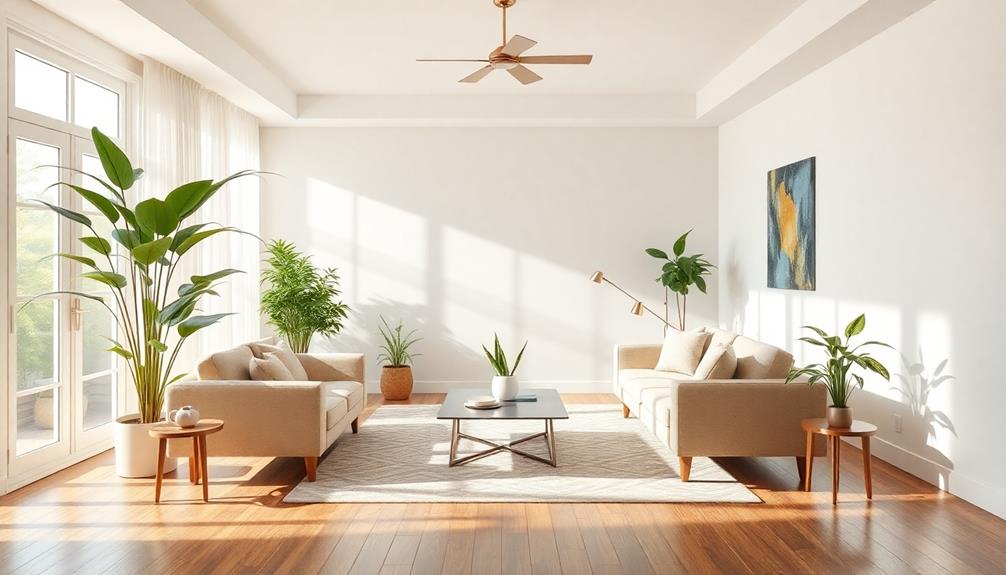
To truly harness the power of Feng Shui, you need to grasp its core concepts.
Understanding the balance of Yin and Yang, the Five Elements Theory, and how to use the Bagua map will help you create a harmonious living space.
Integrating elements such as Indonesian Decorative Pillows can further enhance the vibrancy and comfort of your environment.
These principles are essential for enhancing your well-being and transforming your environment.
Yin and Yang Balance
Achieving balance between Yin and Yang is essential for creating a harmonious environment. These dual forces represent the interplay of energies in nature, with Yin embodying passivity and receptivity, while Yang symbolizes activity and assertiveness. In Feng Shui, understanding this balance can transform your space, promoting well-being and positive Chi flow.
To help you visualize the Yin and Yang balance, consider the following table:
| Yin Elements | Yang Elements |
|---|---|
| Darker colors | Bright colors |
| Soft textures | Sharp angles |
| Quiet spaces | Lively sounds |
In practice, integrating both energies in your surroundings is key. For instance, a serene room with soft lighting and plush furnishings (Yin) can be complemented with vibrant art or a lively music system (Yang). This blend fosters harmony and enhances health, relationships, and prosperity in your life.
Embrace the dynamic equilibrium symbolized by the Taijitu, where the swirling black and white embodies the constant motion of these energies. By consciously cultivating Yin and Yang balance, you'll create a more inviting and nurturing environment.
Five Elements Theory
Understanding Yin and Yang balance naturally leads you to the Five Elements Theory, a foundational concept in Feng Shui. This theory includes Wood, Fire, Earth, Metal, and Water—each element embodies specific qualities that contribute to the overall harmony of your space.
Incorporating natural materials like wood and stone in your decor can enhance the energy flow, aligning with the principles of traditional Indonesian style home decor.
Wood, symbolizing growth and liveliness, is represented by the color green and is linked to the East direction. Incorporating this element can enhance creativity and new beginnings.
Fire, associated with passion and energy, brings warmth and is represented by red, connected to the South.
Earth represents stability and nourishment with its yellow hue, grounding your environment from the Northeast and Southwest.
Metal, linked to clarity and organization, is associated with white and the West and Northwest, helping you achieve focus and structure.
Lastly, Water embodies fluidity and abundance, represented by blue and associated with the North. This element plays a crucial role in enhancing wealth and prosperity energies.
Bagua Map Usage
The Bagua map serves as a powerful tool in Feng Shui, helping you navigate the energy flow in your space. It divides your environment into nine sections, each corresponding to crucial aspects of life such as wealth, relationships, and health. To use the Bagua map effectively, align it with your front door. This way, each area reflects its intended life aspect.
Here's a simple overview of the Bagua map sections:
| Section | Life Aspect |
|---|---|
| Wealth | Prosperity |
| Relationships | Love & Harmony |
| Health | Well-being |
The southeast section focuses on wealth and prosperity, making it important for attracting financial abundance. Incorporate specific colors, elements, and shapes in your decor to enhance the energy flow in each area. Regularly assess and adjust your Bagua map application to maintain a harmonious living environment. By doing so, you're not just improving your space but also nurturing personal growth and balance in your life. Embrace the Bagua map, and watch how it transforms your surroundings into a sanctuary of positivity and prosperity.
Exploring the Five Elements
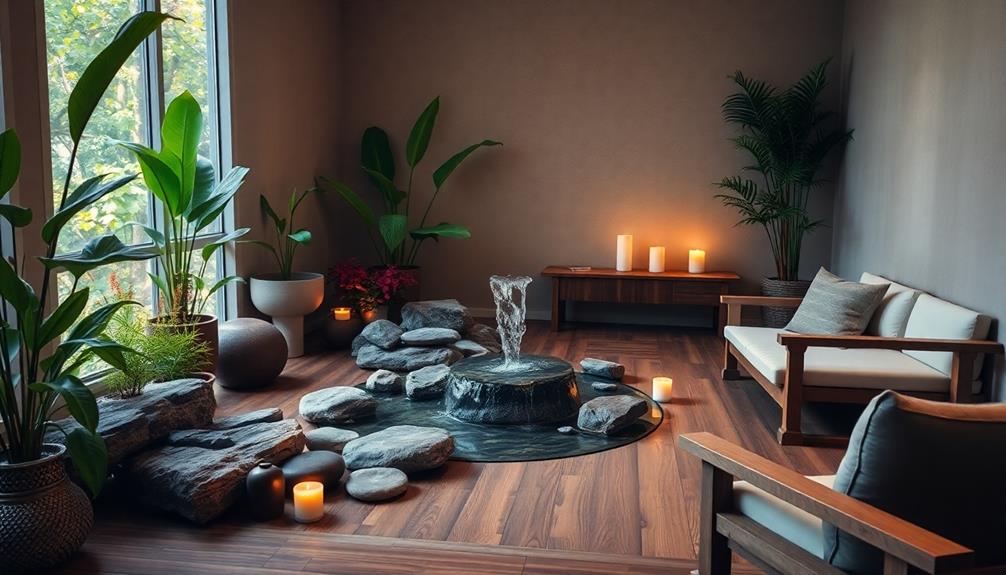
In exploring the Five Elements of Feng Shui, you'll discover how each element—Wood, Fire, Earth, Metal, and Water—holds unique characteristics that can shape your environment.
For instance, incorporating traditional artistry through decor masks can enhance the aesthetic appeal of your space while reflecting rich cultural heritage.
You'll learn about their color associations and how to apply these elements practically in your space to enhance energy flow.
Understanding these elements can empower you to create a balanced and harmonious atmosphere in your home or office.
Elemental Characteristics Overview
Exploring the Five Elements in Feng Shui reveals how each element impacts your life and environment. Understanding these elemental characteristics can help you achieve balance and harmony in your surroundings.
Incorporating elements of design, such as those found in luxury tropical designs, can further enhance the energy of your space. Wood symbolizes growth and liveliness, fostering new beginnings and expansion. Incorporating Wood elements, like plants or rectangular shapes, can energize a space, particularly in the East direction.
Fire, on the other hand, signifies passion and energy. By adding red accents or triangular forms in the South, you can enhance enthusiasm and creativity, igniting the energy in your space.
Earth represents stability and nourishment. Utilizing yellow hues and square shapes, especially in the Northeast and Southwest, nurtures a sense of grounding and security, which is essential for a balanced environment.
Metal embodies clarity and precision. Introducing white tones and circular forms in the West and Northwest can improve organization and focus, sharpening the energy in your space.
Color Associations Explained
Often overlooked, color plays an essential role in Feng Shui, as it aligns with the Five Elements to enhance your space's energy. Each color embodies unique qualities that can bring harmony and balance to your environment.
For instance, the Wood element is represented by green, promoting growth and liveliness, making it excellent for areas focused on health and family connections. Additionally, incorporating decor that reflects cultural artistry, such as Indonesian masks, can further enrich the energy of your space by serving as a conversation starter and a piece of history.
Next, the Fire element is linked to red, symbolizing passion and energy, ideal for spaces where creativity and excitement thrive. If you seek stability and nourishment, consider incorporating yellow to represent the Earth element, perfect for relaxation areas.
White and metallic shades represent the Metal element, promoting clarity and precision, enhancing focus in workspaces.
Practical Applications in Spaces
Understanding how to apply the principles of the Five Elements in your spaces can greatly enhance the energy flow and overall atmosphere. By incorporating these elements, you can create a balanced and harmonious environment.
For instance, consider incorporating vibrant colors and patterns that reflect cultural influences, such as those found in Indonesian wedding decor ideas, to add a dynamic touch to your space.
Here are three practical tips to get you started:
- Wood: Introduce plants or wooden furniture to symbolize growth. This won't only enhance energy flow but also bring a touch of nature indoors.
- Fire: Add candles or red decor to ignite passion and liveliness in your space. This element energizes areas, making them feel lively and inviting.
- Earth: Use yellow colors and square-shaped items, like ceramics or stones, to promote stability. Position these in the Northeast and Southwest areas to foster a grounded atmosphere.
Practical Feng Shui Applications
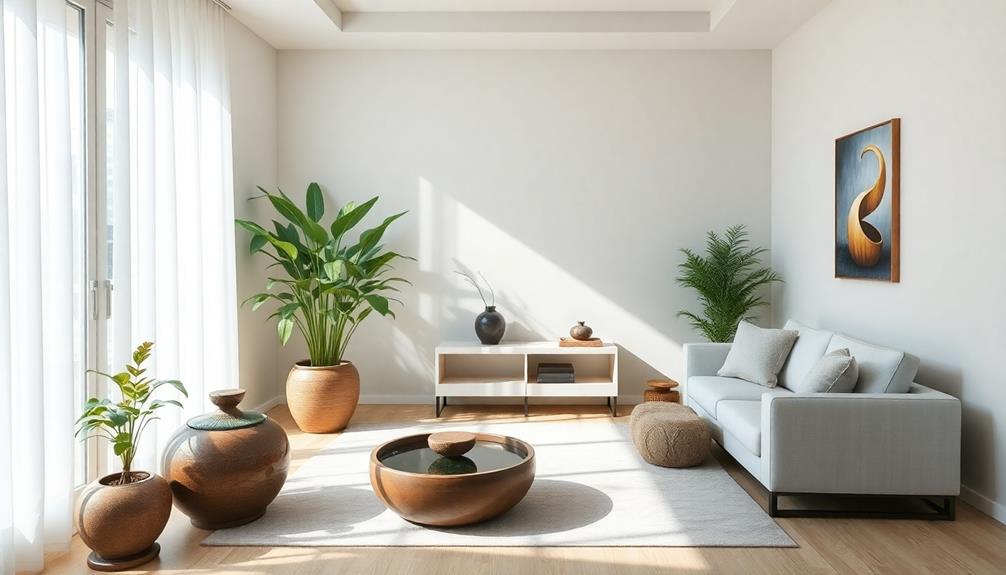
In your quest for a harmonious living space, applying Feng Shui principles can make a significant difference. Start by decluttering your home; a cluttered space disrupts the flow of positive energy, preventing abundance and harmony.
Next, focus on the southeast corner of your home, which is essential for wealth energy. Here's a useful table to guide you:
| Element | Suggestions |
|---|---|
| Color | Use purple, green, or gold |
| Decor | Add plants or a water feature |
| Shape | Incorporate round objects |
| Material | Opt for wood and ceramics |
Incorporating natural elements like plants not only aligns with the Five Elements theory but also elevates energy levels. Utilize the Bagua map to enhance key life areas, aligning specific colors and materials with each sector's energy.
Integrating Feng Shui Into Daily Life
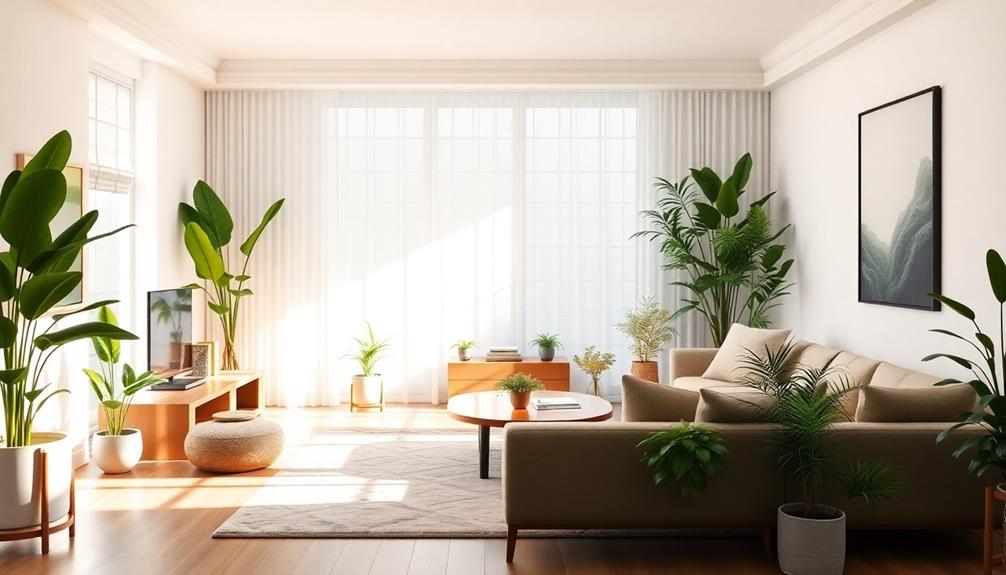
Integrating Feng Shui into your daily life can transform your home into a sanctuary of balance and positivity. By making small adjustments, you can enhance the energy and promote a harmonious flow of energy throughout your living space.
For instance, consider how tropical villa plans emphasize open spaces and natural light, which can greatly improve the overall Chi in your home.
Here are three essential steps to get started:
- Declutter Regularly: Clear out unnecessary items that block the flow of energy. A tidy space fosters positive Chi and creates a calming environment.
- Utilize the Bagua Map: Identify key areas in your home using the Bagua map. For instance, enhance the wealth corner in the southeast by incorporating elements like plants or wooden furniture to symbolize growth and prosperity.
- Incorporate the Five Elements: Use colors, shapes, and materials that resonate with the five elements—wood, fire, earth, metal, and water. This not only enhances the energy but also creates a balanced atmosphere.
Modern Techniques and Approaches
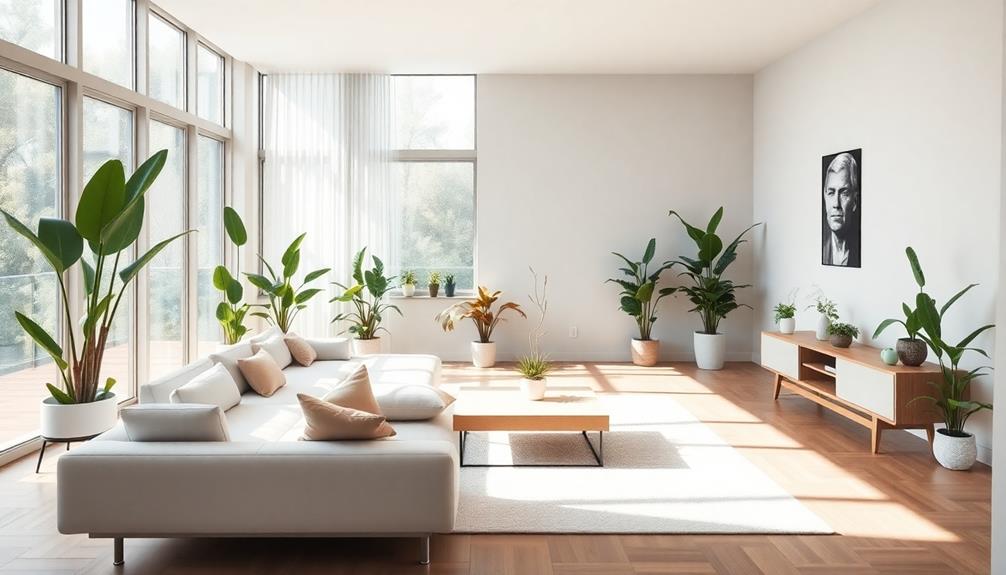
As you embrace the principles of Feng Shui in your daily life, exploring modern techniques and approaches can further enhance your living environment. One effective method is the Compass School, which utilizes cardinal directions to optimize the flow of energy in your space. By aligning your furniture and decor with these directions, you can create a more harmonious atmosphere.
Incorporating unique decor elements, such as a Face Indonesian Decor Mask, can also enrich your space while celebrating cultural heritage. Additionally, the Black Hat Sect merges Western psychology with traditional Feng Shui principles, emphasizing personal empowerment through color, light, and sound. This approach allows you to enhance your space in ways that resonate with your emotional well-being.
Using tools like the Bagua map and Eight Trigrams can help you optimize object placement, ensuring that energy dynamics support your goals. Recent trends show a growing interest in these practices, promoting holistic living through mindful design.
For those looking for advanced methods, consider Flying Star Feng Shui, which analyzes time-based energy shifts. By adjusting your environment seasonally, you can maintain balance and harmony throughout the year.
Embracing these modern techniques won't only enhance your space but also enrich your life.
Enhancing Specific Life Areas
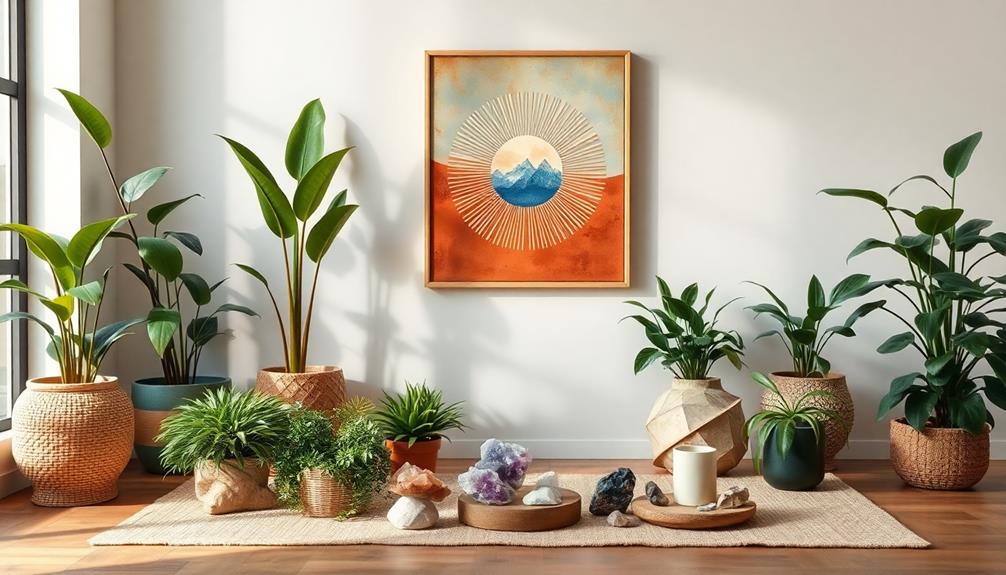
To enhance specific life areas in your home, start by using the Bagua map, which helps you identify key sections that influence various aspects of your life.
This powerful tool divides your space into nine sections, each corresponding to different life areas, including wealth, relationships, and career.
Here are three ways to enhance those areas:
1. Wealth Corner: Focus on the southeast corner of your home, where you can incorporate elements like wood and water to boost prosperity energy.
Use colors like purple, green, and gold in decor to attract wealth.
2. Family Harmony: In the east section of your space, vibrant plants can greatly improve family harmony and strengthen connections among family members.
They also promote a positive flow of energy.
3. Career Opportunities: In the north area of your home, consider adding water features to boost career opportunities, as this direction encourages the flow of energy related to professional growth.
Creating Harmony at Home
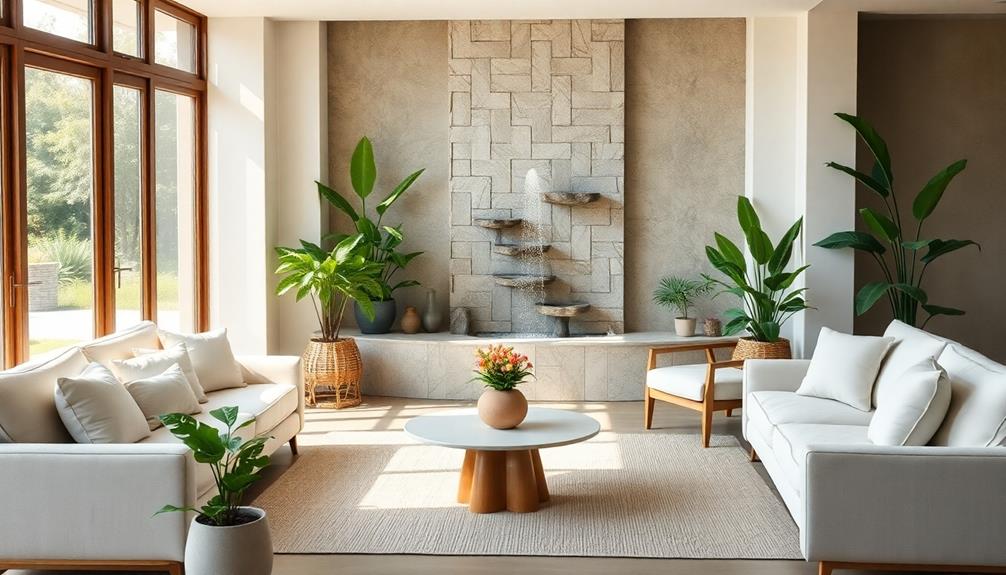
Creating a harmonious environment in your home is all about fostering a balanced flow of energy. In Feng Shui, this means starting with decluttering. Clear out any items that no longer serve you. This creates space for positive Chi to flow freely, enhancing the overall harmony in your living space.
Next, utilize the Bagua map to identify areas in your home associated with different aspects of life, like relationships and wealth. This tool will guide you in adjusting your space to align with your goals.
Incorporating the five elements—Wood, Fire, Earth, Metal, and Water—into your decor can further balance energy. For instance, adding plants (Wood) or a small water fountain (Water) can elevate the vibrancy of your space.
Don't forget about natural light and fresh air; they're essential in maintaining a healthy atmosphere. Open windows and use mirrors to amplify light.
Lastly, pay attention to your furniture placement and color schemes. Strategic arrangements and calming colors create a welcoming environment, allowing the flow of energy (Qi) to enhance your well-being.
Frequently Asked Questions
Is Feng Shui Illegal?
No, Feng Shui isn't illegal. It's a respected practice aimed at creating balance in your environment. You can freely incorporate its principles into your home or workspace, as it aligns with design and building regulations.
What Is the Rule of 3 in Feng Shui?
Imagine a trio of vibrant flowers dancing in the breeze. The Rule of 3 in Feng Shui encourages you to group elements in threes, enhancing energy flow, promoting balance, and creating harmony in your space.
How to Attract Money Immediately Feng Shui?
To attract money immediately, enhance your southeast corner with clean space, wooden elements, and flowing water. Incorporate purple, green, and gold decor, and keep it tidy to allow positive energy and abundance to flow freely.
What Is Bad Feng Shui for a House?
Bad Feng Shui for your house includes clutter blocking energy flow, sharp corners causing discomfort, dark spaces leading to lethargy, unbalanced elements disrupting harmony, and mirrors reflecting energy away, preventing opportunities and stability.
Conclusion
Embracing Feng Shui might seem overwhelming, but you don't need to make drastic changes to see benefits. Just a few simple adjustments—like decluttering your space or rearranging furniture—can create a sense of balance and harmony in your life. Remember, it's about enhancing your environment to support your well-being. You'll be surprised at how even small shifts can lead to significant improvements in your mood and energy. So why not give it a try? You won't regret it!
